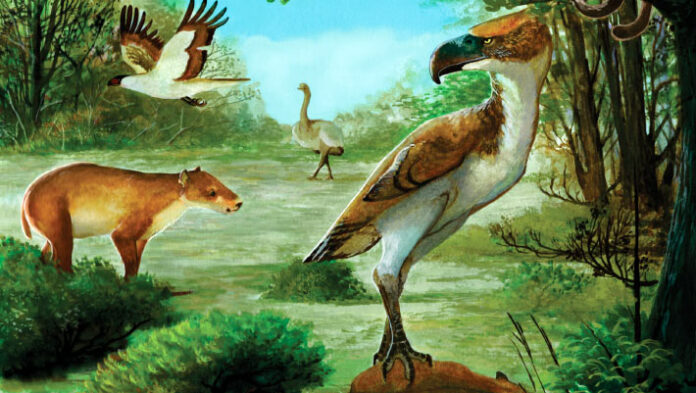Paleontologists have unearthed two fossilized phalanges of an ancient carnivorous bird on Seymour Island, Antarctica.
Paleoenvironmental reconstruction of the Early Eocene continental communities of Seymour Island: a large cariamiform bird hunting a medium-sized ungulate and staring at Notiolofos regueroi, a couple of marsupials on a tree, Antarctoboenus carlinii flying on the sky, and a flightless Ratites in the back. Image credit: Carolina Acosta Hospitaleche & Washington Jones, doi: 10.26879/1340.
The ancient bird fossils were found in the La Meseta Formation on Seymour Island in West Antarctica.
“These phalanges belonged to a large giant predator, estimated to have had a body mass of around 100 kg,” said Dr. Carolina Acosta Hospitaleche from the Universidad Nacional de La Plata and Dr. Washington Jones from the Uruguay’s Museo Nacional de Historia Natural.
The specimens are approximately 50 million years old (Early Eocene epoch).
They belong to a type of phorusrhacid (commonly known as terror birds), an extinct family within the order Cariamiformes.
“Cariamiformes is an order of mainly terrestrial birds that exhibits a significant past diversification but only two species are living today in South America,” the paleontologists said.
“Despite the rich fossil record, the phylogenetic and biogeographic relationships within this order remain poorly understood.”
“Within the Cariamiformes, Phorusrhacidae composes the crown-group with Cariamidae, while Idiornithidae and Bathornthidae have been identified recoveredidentified as fossil families.”

The fossilized phalanges of an ancient cariamiform bird from Seymour Island, Antarctica. Scale bar – 10 mm. Image credit: Carolina Acosta Hospitaleche & Washington Jones, doi: 10.26879/1340.
The Antarctic terror birds most likely preyed on small marsupials and medium-sized ungulates.
“They would be active hunters that fulfilled the role of continental apex predators apparently sub-occupied by mammals in the Paleogene Antarctic communities,” the researchers said.
“Large Phorusrhacidae-like birds represent a guild hitherto unknown to Antarctica.”
“These findings unequivocally reshape our understanding of the dynamic of Early Eocene Antarctic continental ecosystems.”
The results appear online in the journal Palaeontologia Electronica.
_____
Carolina Acosta Hospitaleche & Washington Jones. 2024. Were terror birds the apex continental predators of Antarctica? New findings in the early Eocene of Seymour Island. Palaeontologia Electronica 27 (1): a13; doi: 10.26879/1340


